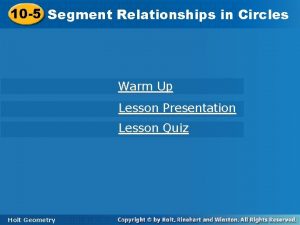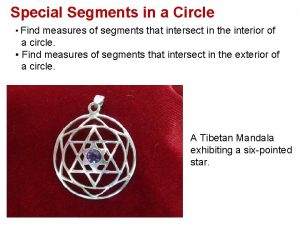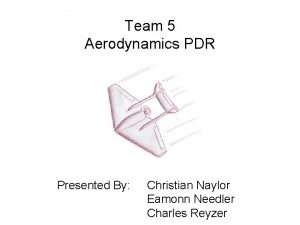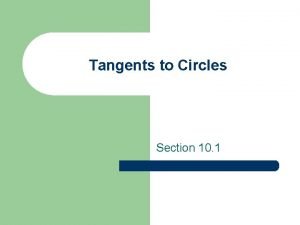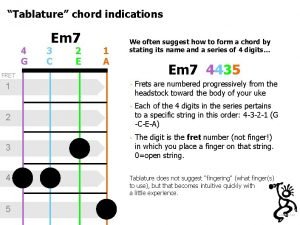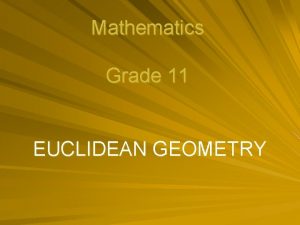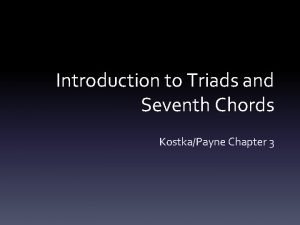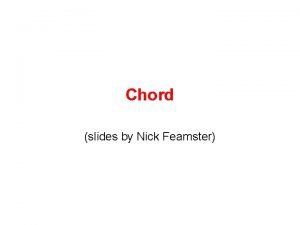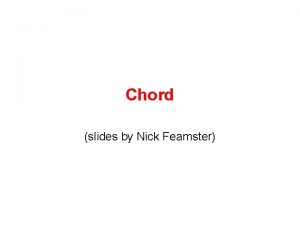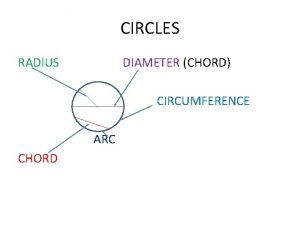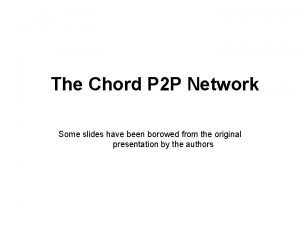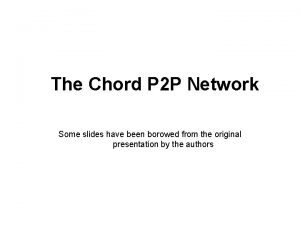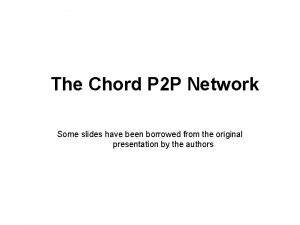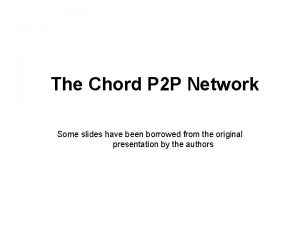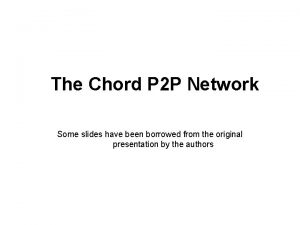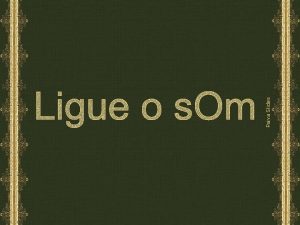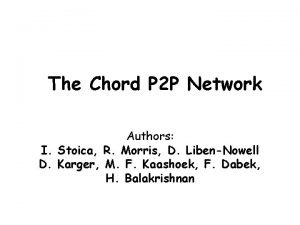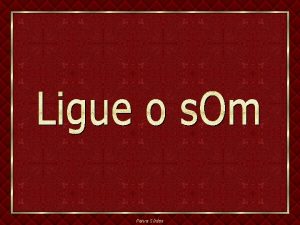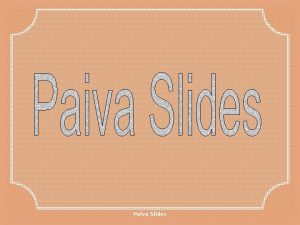The Chord P 2 P Network Some slides





![Consistent hashing [Karger 97] Key 5 Node 105 K 5 N 105 K 20 Consistent hashing [Karger 97] Key 5 Node 105 K 5 N 105 K 20](https://slidetodoc.com/presentation_image/375ae1fd8c937d94702782c3950da19a/image-6.jpg)












![Concurrent Join n 1 New node n’ New node n n 2 [Before] New Concurrent Join n 1 New node n’ New node n n 2 [Before] New](https://slidetodoc.com/presentation_image/375ae1fd8c937d94702782c3950da19a/image-19.jpg)



- Slides: 22

The Chord P 2 P Network Some slides taken from the original presentation by the authors

Main features of Chord • • Load balancing via Consistent Hashing Small routing tables: log n Small routing delay: log n Fast join/leave protocol

Consistent Hashing Assigns both nodes and objects from an m-bit key. Order these nodes around an identifier circle according to the order of their keys (0. . 2 m-1). This ring is known as the Chord Ring. Object with key k is assigned to the first node whose key is ≥ k (called the successor node of key k)

Consistent Hashing D 120 (0) N 105 D 20 N=128 Circular 7 -bit ID space N 32 N 90 D 80 Example: Node 90 is the “successor” of documen

Consistent Hashing Property 1 If there are N nodes and K keys, then with high probability, each node is responsible for (1+ )K/N keys. ( = O(log N) Property 2 When an (N+1) joins or leaves the network, the responsibility of at most O(K/N) keys changes hand (only to or from the node that is joining or leaving. When K is large, the impact is quite small.
![Consistent hashing Karger 97 Key 5 Node 105 K 5 N 105 K 20 Consistent hashing [Karger 97] Key 5 Node 105 K 5 N 105 K 20](https://slidetodoc.com/presentation_image/375ae1fd8c937d94702782c3950da19a/image-6.jpg)
Consistent hashing [Karger 97] Key 5 Node 105 K 5 N 105 K 20 Circular 7 -bit ID space N 32 N 90 K 80 A key is stored at its successor: node with next higher ID

The log N Fingers (0) 1/4 1/2 Distance of N 80’s neighbors from N 80 1/8 Circular (log N)-bit ID space 1/16 1/32 1/64 1/128 N 80 Each node knows of only log N other nodes.

Finger i points to successor of N 120 112 ¼ 1/8 1/16 1/32 1/64 1/128 N 80 ½ i n+2

Chord Finger Table N 32’s Finger Table (0) N 113 N 102 N=128 N 32 N 85 N 40 N 80 N 79 N 52 N 70 N 60 33. . 33 34. . 35 36. . 39 40. . 47 48. . 63 64. . 95 96. . 31 N 40 N 52 N 70 N 102 Finger table actually contains ID and IP address Node n’s i-th entry: first node n + 2 i-1

Lookup Greedy routing (0) N 113 N 32’s Finger Table N 102 N 32 N 85 N 40 N 80 N 52 N 79 N 70 N 60 33. . 33 34. . 35 36. . 39 40. . 47 48. . 63 64. . 95 96. . 31 N 40 N 52 N 70 N 102 N 70’s Finger Table 71. . 71 N 79 72. . 73 N 79 74. . 77 N 79 78. . 85 N 80 86. . 101 N 102. . 5 N 102 6. . 69 N 32 N 80’s Finger Table 81. . 81 N 85 82. . 83 N 85 84. . 87 N 85 88. . 95 N 102 96. . 111 N 102 112. . 15 N 113 16. . 79 N 32 Node 32, lookup(82): 32 70 85.

New Node Join N 20’s Finger Table (0) N 113 N 20 N 102 N 32 N 40 N 80 1 2 3 4 5 6 7 N 52 N 70 N 60 Assume N 20 knows one of the existing nodes. 21. . 21 22. . 23 24. . 27 28. . 35 36. . 51 52. . 83 84. . 19

New Node Join (2) N 20’s Finger Table (0) N 113 N 20 N 102 N 32 N 40 N 80 21. . 21 22. . 23 24. . 27 28. . 35 36. . 51 52. . 83 84. . 19 N 32 N 40 N 52 N 102 N 52 N 70 N 60 Node 20 asks that node for successor to 21, 22, …, 52, 84.

The Join procedure The new node id asks a gateway node n to find the successor of id n. (find_successor(id) if id (n, successor] then return successor else forward the query around the circle fi Needs O(n) messages. This is slow.

Steps in join Linked list insert n n id Successor(n) id Finally But the transition does not happen immediately

A More Efficient Join // ask n to find the successor of id if id (n, successor] then return successor else n’= closest_ preceding_node (id) return n’. find_successor(id) fi // search for the highest predecessor of id n. closest_preceding_node(id) for i = log N downto 1 if (finger[i] (n, id) return finger[i]

Example (0) N 113 N 20 N 102 N 32 N 40 N 80 N 52 N 70 N 60 K 65 N 20 wants to find out the successor of key 65

After join move objects (0) N 20’s Finger Table N 113 N 20 N 102 D 114. . 20 N 32 N 40 N 80 N 52 N 70 N 60 21. . 21 22. . 23 24. . 27 28. . 35 36. . 51 52. . 83 84. . 19 N 32 N 40 N 52 N 102 Notify nodes that must include N 20 in their table. N 113[1]=N 20, not N 32. Node 20 moves documents from node 32.

Three steps in join Step 1. Initialize predecessor and fingers of the new node. (Knowledge of predecessor is useful in stabilization) Step 2. Update the predecessor and the fingers of the existing nodes. (Thus notify nodes that must include N 20 in their table. N 110[1] = N 20, not N 32. Step 3. Transfer objects to the new node as appropriate.
![Concurrent Join n 1 New node n New node n n 2 Before New Concurrent Join n 1 New node n’ New node n n 2 [Before] New](https://slidetodoc.com/presentation_image/375ae1fd8c937d94702782c3950da19a/image-19.jpg)
Concurrent Join n 1 New node n’ New node n n 2 [Before] New node n n 2 [After]

Stabilization Periodic stabilization is needed to integrate the new node into the network and restore the invariant. n 1 New node n n 2 Predecessor. successor(n 1) ≠ n 1, so n 1 adopts predecessor. successor(n 1) = n as its new successor

The complexity of join With high probability, any node joining or leaving an N-node Chord network will use O(log 2 N) messages to re-establish the Chord routing invariants and finger tables.

Chord Summary • Log(n) lookup messages and table space. • Well-defined location for each ID. • No search required. • Natural load balance. • No name structure imposed. • Minimal join/leave disruption.
 Anharmonis
Anharmonis Chord chord product theorem
Chord chord product theorem Chord chord theorem
Chord chord theorem A small child slides down the four frictionless slides
A small child slides down the four frictionless slides Energy release quick check
Energy release quick check They say sometimes you win some
They say sometimes you win some They say it only takes a little faith to move a mountain
They say it only takes a little faith to move a mountain Cake is a countable or uncountable noun
Cake is a countable or uncountable noun Contact forces
Contact forces Fire and ice diamante poem
Fire and ice diamante poem Some say the world will end in fire some say in ice
Some say the world will end in fire some say in ice Some trust in horses
Some trust in horses Jenis c h o r d apa yang disusun oleh nada 572
Jenis c h o r d apa yang disusun oleh nada 572 Grunge vs britpop
Grunge vs britpop Christian naylor
Christian naylor Secant and tangent theorem
Secant and tangent theorem Am7sus
Am7sus Npm throat
Npm throat C69 chord
C69 chord Pepito chord
Pepito chord Renaissance chord progressions
Renaissance chord progressions Theorems of euclidean geometry
Theorems of euclidean geometry Introduction to triads and seventh chords
Introduction to triads and seventh chords

